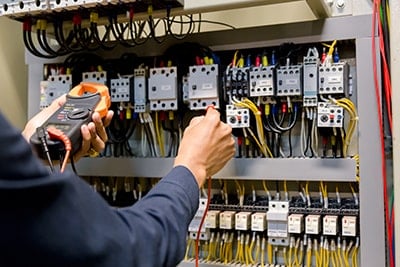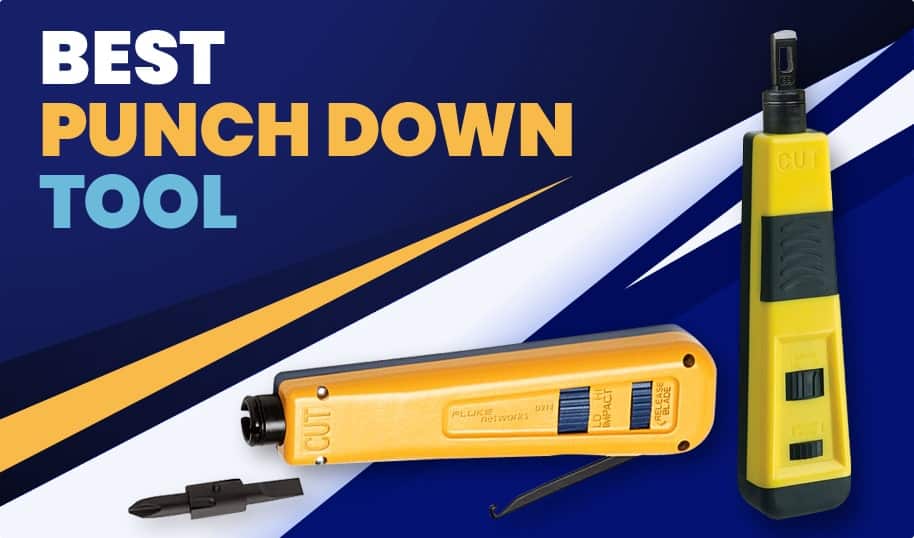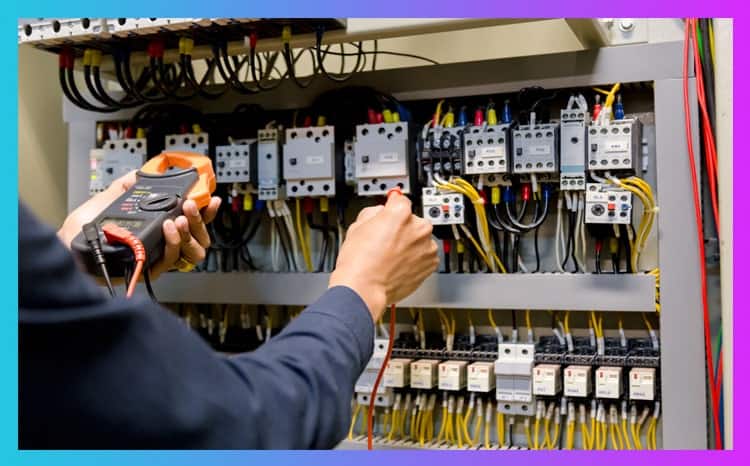
A few months ago, I used my voltage detector pen while fixing the circuit at home and I kept thinking about how this device actually works.
So I decided to draft a comprehensive article about how a voltage detector pen work?
I did a lot of research on how a voltage detector pen functions and found it interesting.
A voltage detector pen works by a process called capacitive coupling. It senses the changing electric field around the “alternating current” or AC conducting objects. These voltage detector pens do not need to get in direct contact with the object for testing the presence of current.
Before I move to explain any further details, it is essential that you understand the functioning of a capacitor.
How Does Voltage Detector Pen Work by Using Capacitor?
The capacitor consists of two conductors that are kept separated with the help of a non-conductor, also known as a dielectric.
When you connect an AC voltage to a capacitor, the current flows across the dielectric or non-conductor.
This is how the circuit is completed even in the absence of wire.
You can have a better understanding of this as per the below diagram.
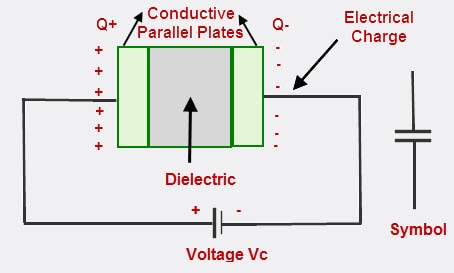
Since now you know the functioning of the capacitor, let me explain how the voltage detector pen works with this capacitor?
The Mechanism
Suppose you have a wire that conducts an electric AC current.
This wire would act as the conductive plate of the capacitor. You may also assume that this is the first side of the capacitor.
The voltage detector pen would work as the other side of the capacitor. The air between the first and second sides acts as the dielectric.
This is how a small capacitor is formed between the wire and the voltage detector pen.
Now the voltage detector pen’s side that you are holding, we have a capacitor, and the person holding it becomes the first conductive plate of this large capacitor.
The ground acts as its second conductive place whereas the sole of the shoe or the carpet would act as the dielectric.
This way a voltage barrier is established between the sensor and the ground.
When you use the voltage detector pen, it detects the AC current flowing through this barrier and indicates its presence.
When the current flows through the pen, you see the light or hear the sound. This is how the voltage detector pen work with a capacitor.
Importance and Advantages of the Voltage Detector Pen Work in Electrician’s Life
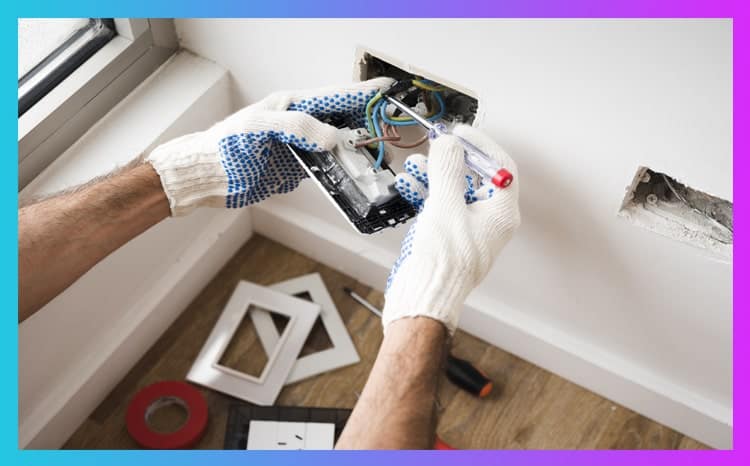
Voltage detector pens are one of the safest equipment that helps you check the presence of AC (or alternating current) current in the object without exposing yourself to the risk of an electric shock.
This device is popular by its other names like test pens, voltage tester pens, or voltage sensors.
As mentioned above, these voltage detector pen work without making direct contact with the conductor. The only requirement is that the person using the detector pen should touch the top of the handle to provide a ground reference. If any presence of AC current is detected, then the indicator LED would be lit up.
Here are some of the advantages of the voltage detector pen:
- They are very compact, lightweight, and small in size compared to multi-meter.
- You can keep them handy and use them without any complications.
- Voltage detector pens are a comparatively cost-effective option to check the presence of AC current through an object.
- You can use it to check for live AC current before commencing work on the object.
- They are durable and can withstand a high load of electricity.
How to Make the Best Use of a Voltage Detector Pen
You must always check for the manual and peruse the instructions carefully before you start using the voltage detector pen.
The same goes for any electrical device. Working with electricity is a dangerous errand, and you need to be cautious when working around live circuits.
Reading the instructions would help you get acquainted with the functioning of the Voltage Detector Pen.
There are three steps to check the voltage detector pen work:
- The first thing I normally do is check whether the detector pen is working properly. I check it with a live object carrying AC current like a lamp. When the indicator shows the presence of current I move to the next step.
- Now I check it with an object that does not carry any AC current. The light or sound should not be indicated.
- Checking the voltage detector pen against different equipment is one of the best methods to confirm whether the voltage detector pen is functioning correctly or not.
Best Practices For Voltage Detector Pen Work
- You need to check the voltage of the wire before starting to work and even after the disconnection of the wire from the socket. This would help you to ensure that it is not energized.
- You must place the voltage detector pen on the faceplate of the small plug slot when you are testing an electrical outlet or receptacle.
- It is also a good practice to check all outlets. Sometimes, they are wired differently or on incorrect circuits. You know, you can never be too careful while dealing with live power!
- You must always let the light switch stay on when you check the receptacle connected to the wall switch.
- If you want to test the power switches, you must remove the power plate. Then you should place the voltage detector pen on the screw sides of the switch.
- When you test a three-way switch, you must test all the terminals on both switches.
- If you are testing a light fixture, turn the circuit off from the main pane. Also, ensure that the light switch stays on. Then, you should unscrew the light bulb and place the voltage detector pen in the center socket button.
- When you test a fixture with two switches, always test the switches in up and down positions.
Components of the voltage detector pen
To understand how a voltage detector pen work, one needs to know the various components of the voltage detector pen.
I have listed the few important components of a Voltage Detector Pen as below:
The body
The body of the voltage detector pen consists of a plastic shell containing this device’s electronic circuit. This is part that you hold for voltage detector pen work. It has a cylindrical shape, but it might vary depending on the brand.
Probe or Nose
This component is basically the one that has the tip for probing and is inserted in plug sockets. It tapers like a pen or pencil. This is also the part when sensing AC current takes place.
On/Off Button
This button is ideally positioned at the top end of the body as it becomes handy to use from that position. The primary function of this button is to turn off or on the function of your voltage detector pen.
You must read the instruction manual to know how the on/off button on the voltage detector pen work. Also, not all the voltage detector pens have this power button. Therefore, you need to consider the possibility of their power draining faster, which would require you to change or charge batteries.
Voltage detector shapes
Few companies provide various-shaped noses to facilitate the voltage detector pen work in all types of sockets. These types of detectors are rare and have more square shapes.
Sensitivity scale
Every voltage detector pen has a specific range to detect the voltage. Some voltage pen detectors can adjust the range to detect the voltage. The sensitivity scale has a turning dial that lets you adjust the detectable voltages.
Let me explain this in detail. When you increase the sensitivity scale of your voltage detector pen, they can detect the volt from a farther distance as they can pick up electromagnetic waves from a distance. Decreasing its sensitivity scale would mean you will have to closer to the object to check the presence of AC current.
Torch
Some voltage detector pens have a small torch usually found at the probe tool. The torch comprises LED bulbs and is operated by a button. These are provided so that you can work in areas with poor visibility.
Battery checker
This is one of the most critical components in your voltage detector pen. It is like an indicator that lets you know the battery levels by pushing a button. You can use this before you start working on any project so that you do not have to work with the drained battery, which would give out false results.
Clip
The clip is just like the one you would see on a pen. The basic purpose of this component is to help you hook the voltage detector pen in your pockets.
Voltage Detector Pen False Positive
Each voltage detector pen has a different setting which depends on the manufacturer or its intended use.
They also have different false positive setting. It is very important that you know how the voltage detector pen work for such scenarios.
Stray Voltage
The stray voltage is normally associated with the connections within the utility supply. Sometimes this might even show up in residential places.
Static Voltage
Sometimes even when you are holding the voltage detector pen still, it will not show any voltage. But later when you move the tester through the component’s surface, you will get a positive reading.
This happens when there is some type of residual voltage in the system which depicts the improper working of the earthing or bonding system.
Ghost Voltages
Ghost voltages are unpredictable and can set off your voltage detector pen and therefore you should look out for disconnected wiring near an energized wire.
Understanding How a Voltage Pen Detector Work in Comparison to a Multimeter
One of the major differences between a voltage pen detector and a multimeter is that the former is used to detect the presence of AC voltage and the latter is used to measure the extent of its presence.
The utility of a voltage detector pen is commonly to detect the presence of electricity AC current before you start working.
Ideally, electricians or DIYers check the presence of any current before commencing any work.
I strongly recommend that this safety measure be practiced religiously before any electrical task.
But that is the only purpose of a voltage pen detector.
Whereas, if you want to measure the voltage or resistance, then you would need a more sophisticated device like a multi-meter.
It is more advanced and gives you an accurate measure of the current. It is however not as handy as a voltage detector pen.
Another important difference between each is the voltage pen detectors only work for AC current and not for DC current. Whereas, you can use the multimeter to check both types of electric currents.
The more sophisticated digital multimeters can measure a variety of things like resistance, the voltage to humidity, inductance or frequency.
You can use the voltage detector pens for smaller tasks and smaller appliances.
On the other hand, the multimeters can be used for industrial work, lab testing, large domestic appliances, power supplies, etc.
How does a voltage detector pen work while testing Christmas lights?
I did this last year at my home and created a step by step list so that you can use your voltage detector pen to test your Christmas lights.
- First, you should plug the lights in the outlet.
- Next, you access the light from this outlet to the other end of the string.
- Now press the power button to start the voltage detector pen’s function and place it near the lightbulb to measure the voltage.
- You do not need to touch the bulbs for the device to work.
- If the voltage detector pen lights up or makes the sound, then you can elude the presence of the AC current.
- If you do not see any indication on your voltage detector pen, then you are required to change the bulbs.
- When you replace the faulty bulb, make sure to check it again with the help of your voltage detector pen. If the new bulb still does not give out any reading on the volt pen, then there must be some issue with the wiring.
Troubleshooting your Voltage Detector Pen
While it is conceivable to investigate electrical issues with an AC voltage locator that isn’t what it is intended for and the strategy doesn’t generally work.
Close by objects of voltage can frequently be mistaken by the voltage detector pen, especially fluorescent lights.
The voltage detector pen will frequently misunderstand this as voltage and will make you feel that a wire they are contacting is hot.
While I have utilized my voltage detector pen to locate the messed up bulb in a line of Christmas tree lights, I have fizzled in the undertaking as a general rule.
The wound wire in these series of lights will frequently actuate a little voltage in the nearby wire—insufficient to light the series of lights but rather enough to set off the voltage indicator.
As an electrical expert, I frequently utilize my voltage detector pen to investigate flawed electrical circuits, however, stay mindful that a false positive result is consistently conceivable.
That is, the voltage pen detector may demonstrate the nearness of voltage when there is either no voltage at all or simply static got from encompassing hot wires.
Proper safety measures must be taken while using a voltage detector pen.
Voltage detector pen work perfectly if it has these qualities
- They must be able to detect high and low voltage
- It should give both – light and sound indication if they find the presence of electric current in the object.
- The availability of auto switch-off feature can help you save sufficient battery life.
- It should be water-resistant.
- The colour of the voltage detector pen should be bright so that you can easily find it.
- It should have rechargeable batteries.
- The voltage detector pen’s tip should have narrow tips so that it can show accurate results even when working around numerous wires.
Voltage detector pen work but they do have some drawbacks
- You cannot use this voltage detector pen for DC currents as their capacitors and transformers do not work with it.
- These testers cannot measure the voltage of current and can only show the presence of voltage if any.
Final Words
Working with electricity requires you to be very careful as far as safety is concerned.
There are many electrical devices that make sure you stay safe while working with electrical equipment.
A voltage detector pen is one such important equipment.
Understanding how the voltage detector pen work is important not only for the adroit electricians but also for the newbies and DIYers.
This article was written to give you a clear idea about how the voltage detector pen work.
I hope you liked the article and the information provided proves to be helpful to you.

